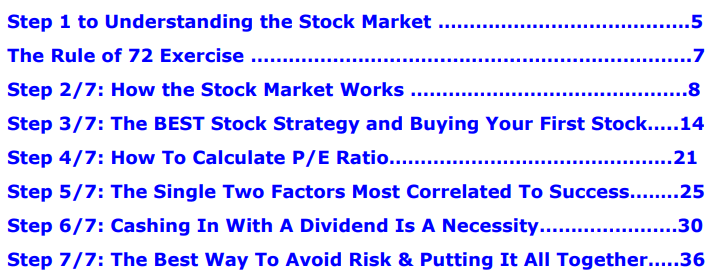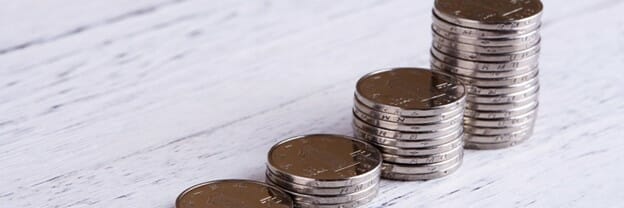Updated 4/21/2023
When done correctly, stock investing can lead to long-term wealth. But how do we start?
Starting to invest can be a scary, intimidating process at first.
The learning curve to understand the stock market and putting money at risk scares most beginners away. But investing remains one of the safest ways to build your wealth.
We always need to remember that EVERYONE starts somewhere. Even the great Warren Buffett had to start at the beginning.
So how do we move past the fear and intimidation?
We can start with Andrew’s great pdf, 7 Steps to Understanding the Stock Market.

If you’re reading this blog, then you likely know Andrew Sather. Maybe you have read some of his blogs, listened to his podcast, or even used his Value Trap Indicator to help you find undervalued companies vs. their intrinsic value.
But if you haven’t downloaded the free PDF at stockmarketpdf.com, then what are you doing?
In today’s post, we will learn:
- What is In the 7 Steps Pdf?
- The “Whys” of Investing
- A Sampling of Stock Market Basics
- Focusing on the Fundamentals
- Putting It All Together
Okay, let’s dive in and learn more about the 7 Steps to Understanding the Stock Market.
What is In the 7 Steps Pdf?
The 7 Steps Pdf contains tons of knowledge to help you overcome fear. It helps you understand the stock market from a high-level view.

For example, Andrew discusses the concepts of compounding, the rule of 72, and what a stock is.
A snippet of the book reveals that owning a stock is owning a part of Google, for example. It is more than a ticker on a phone screen; it’s actual ownership of a piece of Google.
How cool is that?
We can walk around telling friends and family I am a business owner of Google.
The PDF contains 32 pages, which may initially sound overwhelming, but each chapter breaks the concepts into nuggets you can easily understand.
In reality, in about 30 minutes, you can go from being a complete novice to understanding the stock market and how it works. And best of all, it removes the fear of the unknown, which scares away most beginners.
Each chapter builds on the knowledge from the previous chapter. Helping you compound your knowledge; see what I did there?
The “Whys” of Investing
One of the many reasons people start investing is to grow their wealth. In some cases, they might be saving for retirement. In others, they might be saving for their children to set them up for a better life.
Whichever reason you start, we should understand the whys of investing.
Andrew breaks down the power of compounding in the first several chapters, for example. Using compounding power, we can leverage the stock market to build wealth.
What is compound interest, you ask?
As Albert Einstein reportedly said, “Compound Interest is the eighth wonder of the world. He who understands it earns it…he who doesn’t, pays it.”
Compound interest drives the stock market; below is a great example from Andy Shuler of how it can work:
“For example, if you earn 6% on $1000, you will then have $1060. But, the next time you earn 6% interest, it will now be on $1060 instead of $1000, and that then will result in a new value of $1123.60.
Not a huge difference for this time, but it was $3.60 more than that $60 that your 6% interest on $1000 generated.”
Once you understand the power of compounding and what it can do for you, investing will become far more interesting.
Consider this, the richest people in the world all own businesses. Elon Musk, Jeff Bezos, and Warren Buffett, to name a few. All these people own businesses, and their wealth comes from the value of those businesses in the stock market.
A Sampling of Stock Market Basics
The PDF also covers the basics of the stock market by focusing on concepts every beginning investor should know:
- Using investing analysis vs. media noise
- Dollar-cost averaging
- Opening your first brokerage account
- And the fallacy of timing the market
I won’t spoil all the topics for you, but consider investing in a company and buying it based on your findings. And then contrast that with buying a company based on someone screaming on the TV about a can’t-miss prospect.
The person on TV has an agenda: to get you to watch them, exposing us to their advertisers. The longer they get us to watch, the more their station makes, and they too.
They have zero interest in our best interests; it’s about keeping our attention. And in most cases, they attempt to hold our attention by controversy or shocking us with crazy statements.
Instead, Andrew suggests another way. By learning the language of money, you can discover how a company makes money and Google’s “true” value, for example.
It sounds like a much saner, calmer way to make money. Our lives are already crazy enough; why add more chaos??
Focusing on the Fundamentals
Andrew spends some time going through the fundamentals of analyzing a company. Remember, as beginning investors, we are learning the language of money.
Andrew focuses next on some of the most important ratios for identifying successful stocks in the past, such as P/B and P/S, and shows why they’re so impactful.
He talks about the value of dividends and how implementing a DRIP (Dividend Reinvestment Plan) is an extremely effective way to maximize compound interest.
We can use the above ratios as a shorthand for finding great investments.
Andrew walks through each metric in great detail. He uses real-life examples to help you do them on your own. It may sound scary, but once you understand the concepts and where to find the numbers, plug-and-play is an easy matter.
In addition to the numbers, Andrew explains the why, which helps you understand the meaning behind the numbers.
When we invest, we look at a company’s financials, and our job is to Sherlock Holmes the meaning behind the numbers.
It may sound overwhelming, scary, intimidating, or just plain hard. But trust me; you CAN DO THIS!
Remember, we have all been there and done that, along with the greats, Warren Buffett and Charlie Munger.
Putting It All Together
And that’s it! Believe it or not, 32 pages is very concise, considering how much information you are given (for free, I might add). And my favorite thing is Andrew lays it out in such an easy-to-understand way that you can read it as you go through the process.
My favorite way to use the PDF is as a guide as you work through the book. For example, you can use the guide to help you open your first brokerage account. Andrew provides examples of how to do this step-by-step.
The PDF answers many of the questions beginners have: Where do I start? How do I buy my first stock?
No lie – the PDF is one of the first things that got me investing. I had already started before reading it, but it helped me overcome that fear of the unknown.
It’s a perfect introductory PDF that will start your investing journey. It’s what will get you to shift out of park and put the car into drive.
No, you’re not going to know everything, but you’re going to understand compound interest, the importance of investing in the market, and some of the fundamentals that will help you start to identify undervalued companies that you can invest in.
Maybe you don’t get 10% returns. Maybe you make some mistakes, and you only have 5% returns. But guess what – that’s 4.99% more than you’ll get in your savings account.
Our goal at einvestingforbeginners.com is to get you started on your investing journey and get you to put down those initial building blocks that allow you to continue to build.
And again, it’s free – just download the PDF! Your future, early-retired self will thank you for it!
Related posts:
- A Stock Market Basics PDF Written By a Self-Taught Investor [Free Download] Updated 4/21/2023 Starting anything new is scary, and investing is no different. We all have the same questions, where to start? It may seem overwhelming,...
- Warren Buffett Buys American Express Updated 9/3/2023 American Express was one of the turning point investments for Warren Buffett. It began his path to becoming the investor he is now....
- The Intelligent Investor: Is it Outdated? Is it for Beginners? Should I Read it? Edited 3/24/2023 Warren Buffett started learning about investing when he was seven or eight. I know a late bloomer. Buffett’s father started a small investment...
- Seeking Alpha Authors You Can Trust in a Post COVID World One of my favorite places to get investing information has always been Seeking Alpha, but I feel like more and more nowadays, people just are...



